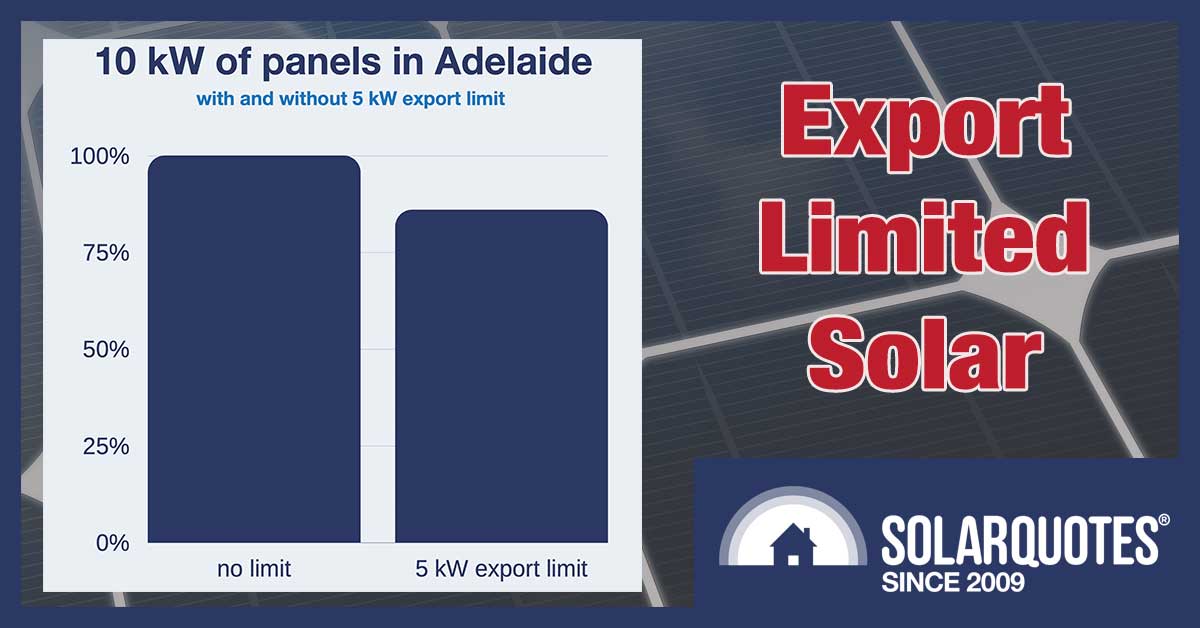
What are the losses from solar export limiting? — You’ll lose less energy generation than you think.
Export limited solar systems are becoming increasingly common.
Some new solar power system buyers are being told they can only proceed with an installation if the installer ‘export limits’ their system.
Export limiting is a polite way of saying ‘hobbled’. An export limited solar system will occasionally send less electricity into the grid than its inverter can supply. That can cause clean solar energy to go to waste.
That sounds awful, but the good news is: the amount lost is far less than most people expect.
If you were planning to install a 10 kilowatt solar system but were told the inverter had to be exported limited to 5 kilowatts — you might cry…
“Nooooooooooooo! Five is half of ten, I will lose half the solar generation!”
But that’s not how it works.
I have used PVWatts to investigate the likely output of export limited solar systems in every Australian capital. I found that — even in an absolute worst-case situation — the maximum amount of generation lost by a 10 kilowatt solar power system installation with a 5 kilowatt export limit is 14%.
In reality, the losses are likely to be considerably less. This because the worst-case situation involves…
- All solar panels facing the same direction.
- No electricity consumption by the household during the day.
While there are homes with large solar systems with all their panels facing the same way, there are damn few that don’t use any electricity at all during the day. Almost everyone has a refrigerator, and most homes have a freezer as well. On top of this, remaining losses can be reduced or even eliminated if a modest effort is made to switch electricity consumption to the middle of the day. For example, homeowners can put electric hot water systems, pool filters, and other appliances on timers so they’ll switch on when solar energy output is high.
In this article I will:
- Give a quick rundown of what solar export limiting is.
- Explain why the losses are usually small.
- Show graphs displaying losses in each Australian capital city in a worst-case situation.
- Finish off by saying, outside of extreme cases, the losses will be low. Then I’ll knock off early and have a liquid lunch.1
Solar Export Limiting Links
- I wrote in detail about export limiting here
- If you want a brief explanation of how export limiting works, you can read this.
- Alternatively, if you only want to know if you can install an export limited system in your area, you find a summary of grid connection rules here.
But if you’re anything like me, you’re not going to bother checking the links, so I’ll start by giving a quick explanation of what export limiting is.
Solar Export Limiting In A Nutshell
There is a limit to how much solar power local grids can accept without grid upgrades. Solutions are being developed and implemented, but there will be constraints until then. Solar export limiting is a useful way to reduce the problem because it can allow many homes to export most of their surplus solar energy. The alternative is a limited number of homes being allowed to export all their surplus solar power, with a big fat zero export limit for anyone installing solar later.
For moderate export limits, the amount of solar energy lost is small. While losing any clean generation is a shame, it’s better than the alternative where every new solar power system installation will be required to have a zero solar export limit because the grid can’t take any more.
My normal advice is to install as much solar as you can reasonably fit on your roof. But if you’re not absolutely flush with cash like I am…

Only a rich man can afford to burn through socks by wearing shoes like this…
I recommend installing as large a system as you can afford. If solar export limiting lets you install a larger system than you otherwise would be able to have, then I heartily recommend it — within reason.
Extreme Export Limiting
There are both good and bad reasons for export limiting a solar system:
- Good: Provided it is permitted at your location — it can allow you to install a larger system than you’d normally be able to.
- Bad: Due to local grid limitations, you can be required to export less to the grid than is normal in your area.
Using Export Limiting To Install A Large Solar System
If you are using export limiting to install a system larger than you’d otherwise be able to, for a typical installation it’s not possible to get too carried away. If, like many Australians, you face the following limits for new solar:
- The maximum amount of solar power that you can export to the grid: 5 kilowatts per phase.
- Maximum solar inverter capacity: 10 kilowatts per phase.
Then export limiting your solar power system installation will allow the capacity of your inverter to be up to 10 kilowatts per phase. This allows single-phase homes to have a large 10 kilowatt inverter, while 3 phase homes can have a massive 30 kilowatt inverter. For a normal installation2 solar panel capacity can be up to one-third larger than the inverter capacity, so the solar panel capacity can’t be more than 2.66 times greater than the export limit. While this large difference can result in losses, for most households, they shouldn’t be excessive.
Exports Limited To Less Than Usual
Unfortunately, an increasing number of Australians who want to install solar panels are told their exports will be limited3. The amount may be very small, or you could even be required to have a zero export limit. If you are faced with a very low or a zero export limit, you’ll have to decide if solar power is still worthwhile for you.
Even with a zero export limit, the good news is that it can still be financially worthwhile to install solar, as I explain in this article.4 A solar power system installation can pay for itself by only providing electricity to the home. In most cases, the system will have to be 6.6 kilowatts or less to keep the length of time required to pay for itself reasonable.
If a home can export any solar power, even if it is just one kilowatt, the financial situation improves considerably. But you may want to reconsider my usual advice of installing as much solar as you can.
Why Losses Are Minor
There are two main reasons why losses from solar export limiting are less than many expect:
- Most of the time, solar inverters operate well below their maximum capacity.
- Electricity consumption by the home reduces losses from export limiting.
Solar System Output Usually Below Maximum
For a solar inverter to provide its maximum output, the following two conditions usually have to be met:
- The solar panel capacity needs to be greater than the inverter capacity.5
- The sun needs to be close to directly over the panels.
It’s normal these days for solar systems to have a panel capacity up to one-third larger than the inverter capacity but — unless your name is Joshua and you blow a mean horn — the sun isn’t likely to stay still in the sky and let you maximize your solar output. Instead, the sun will spend most of the day either climbing up to the optimal position or climbing back down from it. For north-facing solar panels, this means they’ll only be able to provide their maximum output on a clear day around noon.
There are also plenty of other factors that contribute to solar systems normally operating below their potential maximum. These include…
- Clouds, haze, smoke, and smog.
- The low position of the winter sun in the sky — outside of the tropics.
- Heat: All else equal, each 10 degree increase in temperature reduces typical panels’ output by almost 4%.
- Solar panels often don’t face the optimal direction for maximum power output, which is normally north or close to it. They also usually aren’t at the ideal tilt angle.
- Dirt on panels.
- Etc.
So even if a solar power system with a 5 kilowatt export limit has 10 kilowatts of panels, most of the time those panels will be producing less than the 5 kilowatt export limit. At these times, it won’t be possible for solar energy to go to waste.
Household Consumption Comes First
Another major factor reducing losses is the consumption of solar power by the home itself. Only the surplus left over after household demand is met is available for export. So if a home with a 5 kilowatt solar export limit is consuming two kilowatts of power while the solar system produces 7 kilowatts of power, no generation will go to waste.
If no one is at home during the middle of the day, electricity consumption can be low, but most homes have at least a refrigerator running that will consume a portion of the solar energy produced. Even if no effort is made to shift consumption to the middle of the day, a normal home with a refrigerator and freezer will draw enough power to at least reduce losses.
Fortunately, it’s not difficult to shift electricity consumption to the middle of the day. Electric hot water systems and pool filters can be put on timers, as can many other appliances. This is a simple and effective way to reduce or eliminate losses. There are also more sophisticated approaches than using a timer, such as a solar hot water diverter or a relay.
Small Solar Systems & Extreme Export Limits
Self-consumption of solar energy can allow a household to have low losses from export limiting. This can be the case even if the export limit is very low, provided the solar system installation isn’t too large. If there are usually people at home during the day or an effort to shift electricity consumption to the daytime, then a 6.6 kilowatt solar power system can still have fairly low losses even if it has a one kilowatt export limit. But this will, of course, depend on how much electricity is consumed. If your home only averages 4 kilowatt-hours of consumption per day, there will still be plenty of losses in this situation.
I Used PVWatts
To work out the likely losses from solar export limiting in each Australian capital city, I used PVWatts. This handy American site gives estimates of solar output for locations around the world6. It lets you adjust a range of parameters and — within some limits — let me compare the output of systems with and without export limiting.7
One of the limits meant I could only get information for systems with a maximum panel capacity equal to twice their solar export limit. But most people using export limiting to install a large system probably won’t go far beyond this, so it’s not a huge drawback.
The PVWatts site may not be perfect, but I find it’s generally very accurate and I have a considerable amount of trust in the results it gives me. (If the results it gives turn out to be screwy I’m really going to look really stupid after saying that.)
It’s A Worst Case Scenario
There are three things to keep in mind when looking at losses from solar export limiting in the graphs below:
- The results are all based on a worst-case scenario.
- Every scenario is based on a worst-case situation, and finally…
- These scenarios — they don’t get worse than this.
The two main reasons why they are worst-case scenarios8 are:
- It is assumed the home consumes no electricity during the day, which is not realistic.
- All panels are assumed to face the same direction, which is normally not the case for larger solar systems.
While less important, there is another reason why they are worst-case scenarios:
- The results are for a new system installation, and no allowance is made for the slow deterioration in panel output that occurs over time.9 While this should only be around 0.5% a year for decent quality solar panels that have been properly installed, it’s enough to slowly reduce losses from export limiting as the years pass by.
Details Fed To PVWatts
It took me a long time to get all the information out of PVWatts for the capital cities. The process was so tedious it almost drove me to drink.
But in the end, I got it done, after making some decisions on…
- Solar panel direction – North
- Panel tilt – 20º
- Panel capacity and the solar export limit amount – 5, 6, 6.6, 7, 8, 9, 10 kW of panels, 5kW export limit.
Here are the results.
Adelaide
- Solar Export Limit: Normally 5 kilowatts per phase in South Australia.
- Inverter Capacity Limit: Normally 10 kilowatts per phase in South Australia.
Adelaide is the capital with the second-highest losses for export limited systems, mostly thanks to clear summer skies with occasional periods of mild temperatures as cold air moves in from the Southern Ocean. But even in this worst-case situation, an inverter export limited to 5 kilowatts with 10 kilowatts of panels will only lose 14% of total generation. This is in comparison to a 10 kilowatt inverter with 10 kilowatts of solar panels and no export limit.
Brisbane
- Solar Export Limit: Normally 5 kilowatts per phase in Queensland.
- Inverter Capacity Limit: Normally 10 kilowatts per phase in Queensland.
While closer to the equator than Adelaide, losses are lower in Brisbane. This is because Brizzy summers tend to be cloudy with clearer skies in winter, making for more even output through the year. There is no appreciable loss from having an export limit of 5 kilowatts until solar panel capacity reaches 8 kilowatts or more.
Canberra
- Solar Export Limit: Normally 5 kilowatts per phase in the ACT.
- Inverter Capacity Limit: Normally 10 kilowatts per phase in the ACT.
Canberra, the nation’s capital, has the highest losses. This is thanks to clear summer skies. Also, cool clear days in spring and autumn may contribute thanks to reduced losses from heat. But while slightly worse than Adelaide, even in this worst-case situation, only 14% of total generation is lost with 10 kilowatts of panels and a 5 kilowatt export limit. If the solar panels were all facing east or west, the losses would be only 10%.
Many inland locations will have results similar to Canberra, though losses will increase modestly with diminishing average cloud cover.
Darwin
- Solar Export Limit: Normally 5 kilowatt export limit for single-phase homes and 7 kilowatt total export limit for three-phase homes around Darwin, Alice Springs, Katherine and Tennant Creek.
- Inverter Capacity Limit: Same as for the export limit. This means export limiting can’t be used to install a larger system. The graph below ignores this fact so you can see what results export limiting would have.
Darwin stands out as the capital with the lowest losses. This is mainly due to the big wet causing plenty of cloud cover in summer, while the big dry brings winter clear skies. Besides, Darwin is so close to the equator north-facing panels at a 20 degree tilt are sub-optimal for summer generation. Darwin is also unique because it’s the only capital where east and west-facing solar panels have greater losses than north-facing ones. This is presumably due to Darwin’s weird weather combined with being nearly as far north as you can get and still be in Australia.
Hobart
- Solar Export Limit: Normally 10 kilowatts per phase in Tasmania.
- Inverter Capacity Limit: Normally 10 kilowatts per phase in Tasmania. This means export limiting is not required to install a larger system. The graph below shows the worst-case losses if a 5 kilowatt export limit per phase was introduced — which may happen in the future.
Hobart has the second-lowest losses thanks to being the cloudiest capital and about as far south as it’s possible to get without being in Antarctica. The high cloud cover and southerly location are slightly countered because it can get damn cold by mainland standards.
Melbourne
- Solar Export Limit: Depends on location — Normally either 5 or 10 kilowatts per phase. Many new installations in Melbourne are now required to be export limited below the normal 5 or 10 kilowatt amount.
- Inverter Capacity Limit: Depends on location — Normally 5 or 10 kilowatts per phase. Whether export limiting is normally required to install a larger system will depend on location.
Thanks to Melbourne weather only being a modest improvement over Hobart, losses are not very high.
Perth
- Solar Export Limit: 5 kilowatts for single-phase. Potentially equal to inverter capacity for 3 phase but (low) solar feed-in tariff only available to residences with 5 kilowatts of inverter capacity or less.
- Inverter Capacity Limit: 5 kilowatts for single phase. Up to 30 kilowatts for three-phase but 8-22 kilowatts is the usual range allowed.
I expected Perth losses to be similar to those in Adelaide, but the WA capital does slightly better. This is likely due to the higher temperature resulting in fewer cool but clear days.
Sydney
- Solar Export Limit: Normally 5 kilowatts per phase for most Sydney homes but normally 10 kilowatts per phase in the East Sydney Ausgrid area. This means export limiting is normally not required for a large system in east Sydney.
- Inverter Capacity Limit: Normally 10 kilowatts per phase.
Sydney, Australia’s most populous city, is pretty much in the middle in terms of losses for the sub-tropical capitals. Even in this worst-case situation, losses aren’t particularly high and come in at 13% for 10 kilowatts of solar panels with an export limit of 5 kilowatts. In real life, they’re likely to be considerably less.
Losses Are Low
As you can see, even in an absolute worst-case situation where…
- All solar panels face in one direction.
- The system is new.
- The household consumes no power during the day.
The losses from having panel capacity double the solar export limit are no more than 14% in any capital.
This is not a large amount, and because the results are for an absolute worst-case situation, losses should be considerably less under real-life conditions. Having panels face in two or more directions and minimal daytime electricity use is likely to eliminate losses or reduce them to a trivial amount. It also takes little effort to shift electricity consumption to the middle of the day. This can allow a home with a panel capacity well over twice the export limit to experience little or no generation loss. If you own a pool, you’re probably set. You can also use electric hot water systems and other devices to reduce or eliminate losses.
Generally speaking, the larger a solar power system installation is, the lower it will cost per kilowatt of panel capacity. So even if all your panels face one direction and — for some strange reason — you lack the motivation to shift consumption to the middle of the day, it can still make perfect financial sense to install a larger, export limited solar system. Even if you are not certain a larger system will make you financially better off, you are helping future-proof your home for when battery systems become cost-effective or you get an electric car.
Footnotes
- Pepsi and soup. Or if my funds are inadequate — just Pepsi soup. ↩
- Normal in this case is an on-grid installation, uses STCs, and a battery isn’t installed at the same time. ↩
- In some places, being export limited is the new normal. ↩
- While only written a year ago, the article’s already a little dated as the cost of decent quality solar has fallen since then. ↩
- Solar panels can provide more power than their rating, especially when new, but this rarely happens and — in this situation — it isn’t worth worrying about. ↩
- It’s such a relief to be able to mention the PVWatts site is American without having to worry the Trump Administration will realize they’re doing something useful and put a stop to it. ↩
- If you go to “Advanced Parameters” in PVWatts you can change the “DC to AC size ratio” from as low as 0.4 to as high as 2. Setting it to 1 will give the results for a system where the inverter has the same capacity as the solar panels. Setting it to 2 will give results for a system where the inverter capacity is half the panel capacity. I can use this to estimate the output of an export limited system for a home that consumes no electricity during the day. While it’s not the same thing, the results will be very close. ↩
- Besides the fact that PVWatts was only able to provide me with information for worst-case situations. ↩
- Allowance is made for Light Induced Degradation, or LID, that occurs in panels during the first day or two after installation. ↩


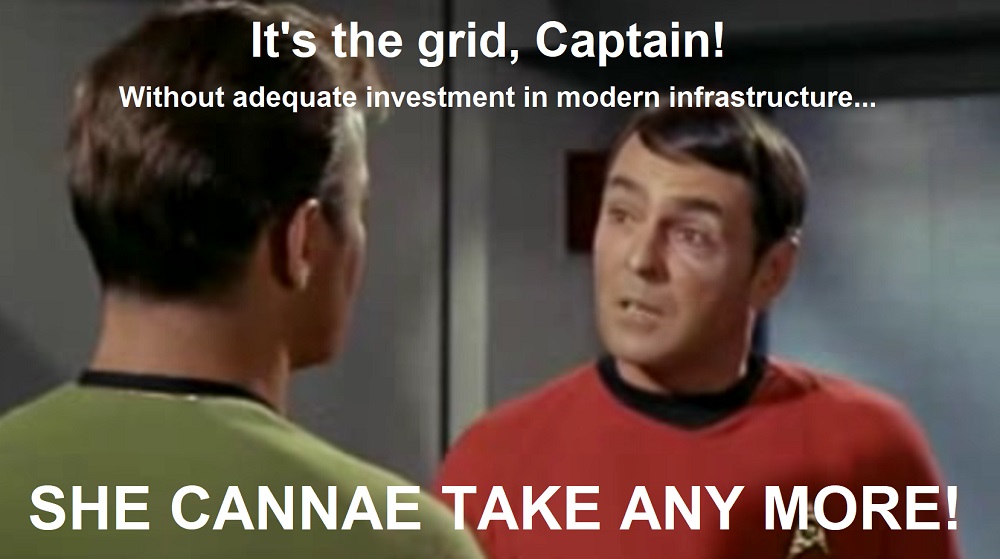



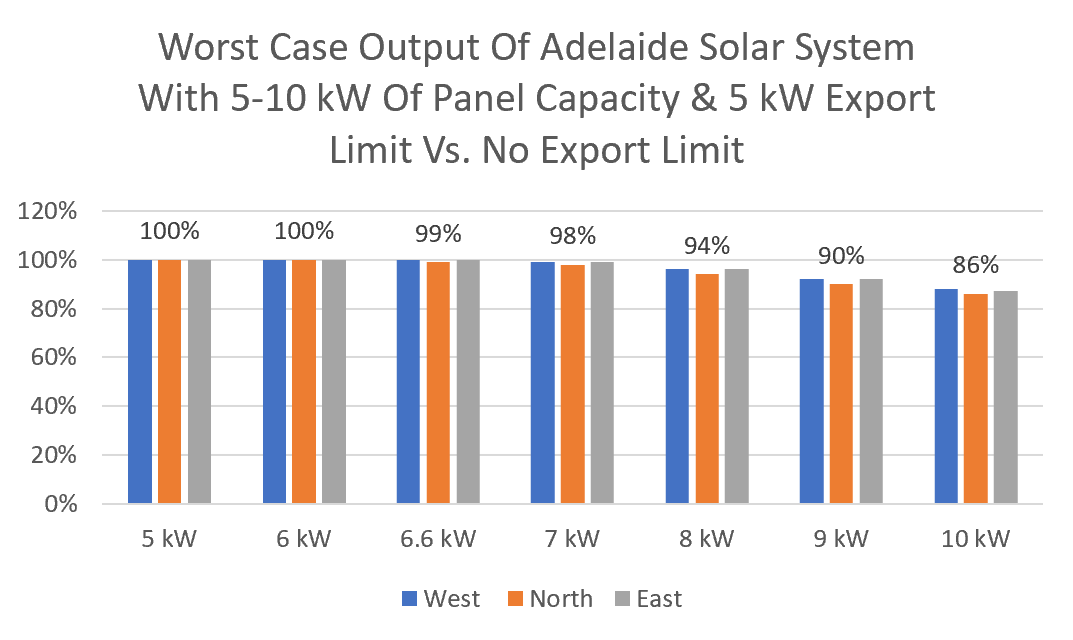
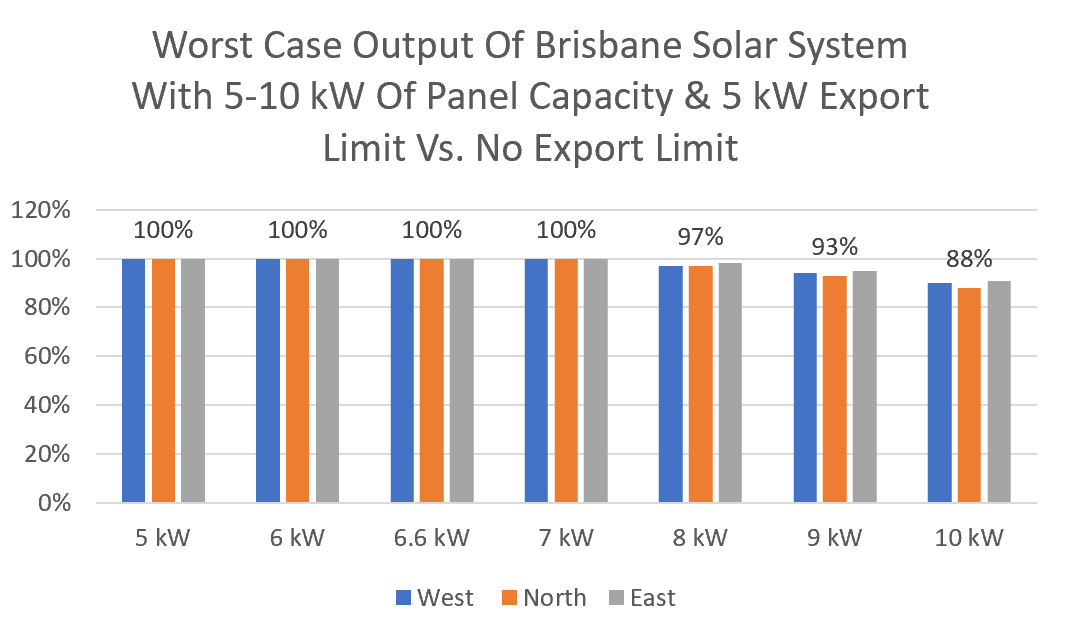
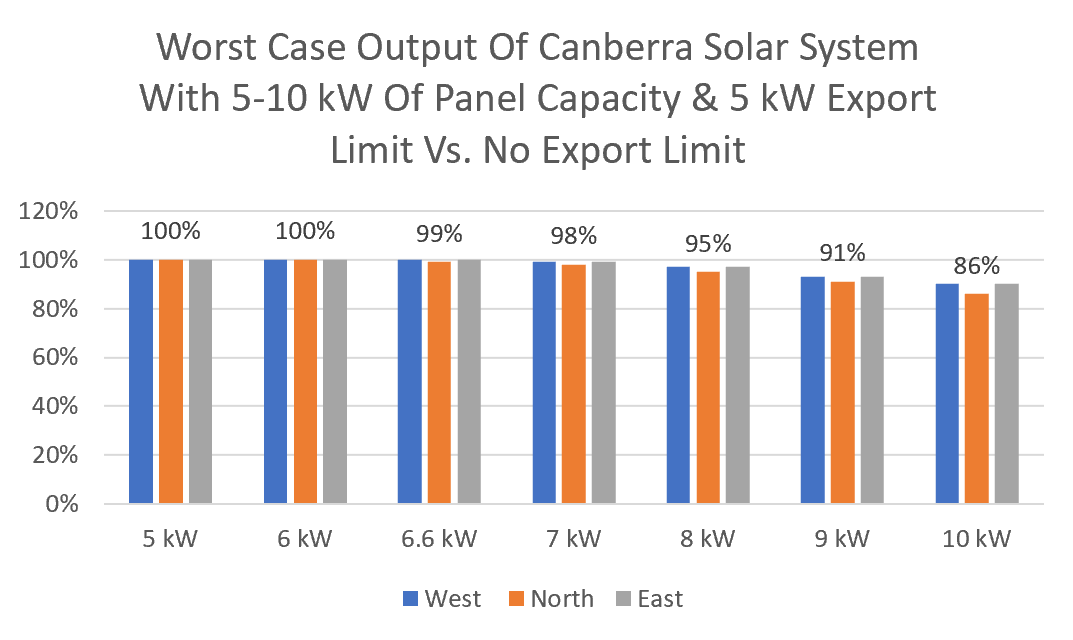
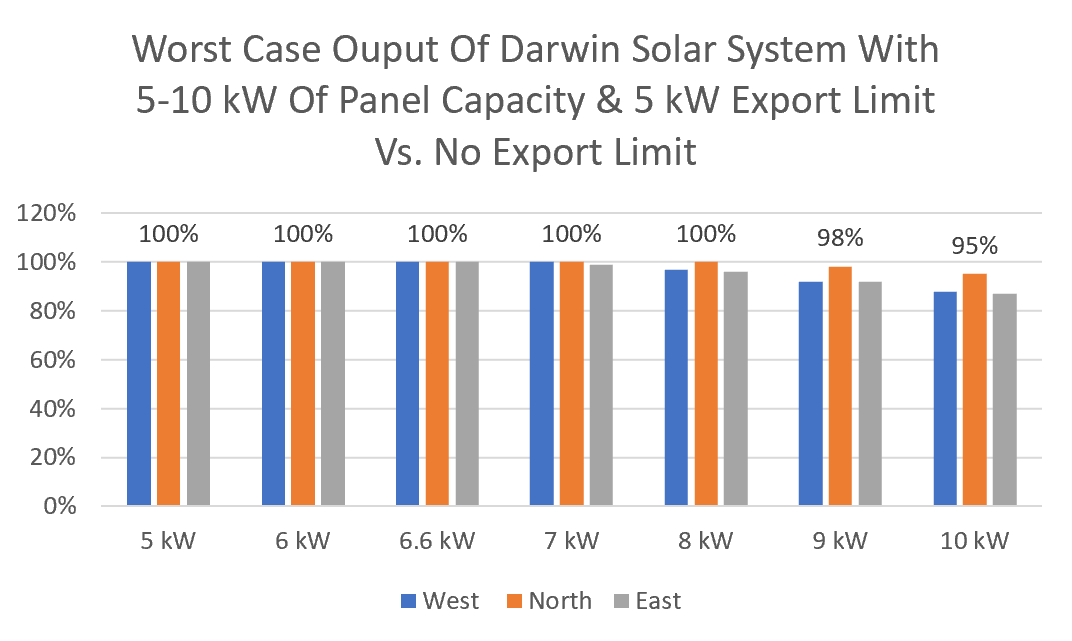
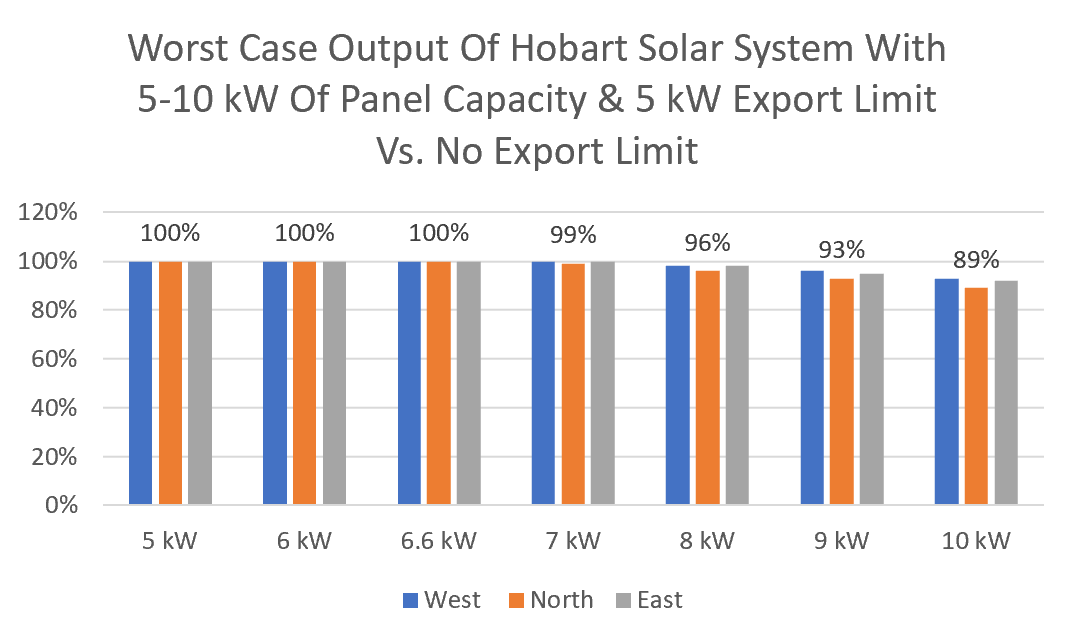
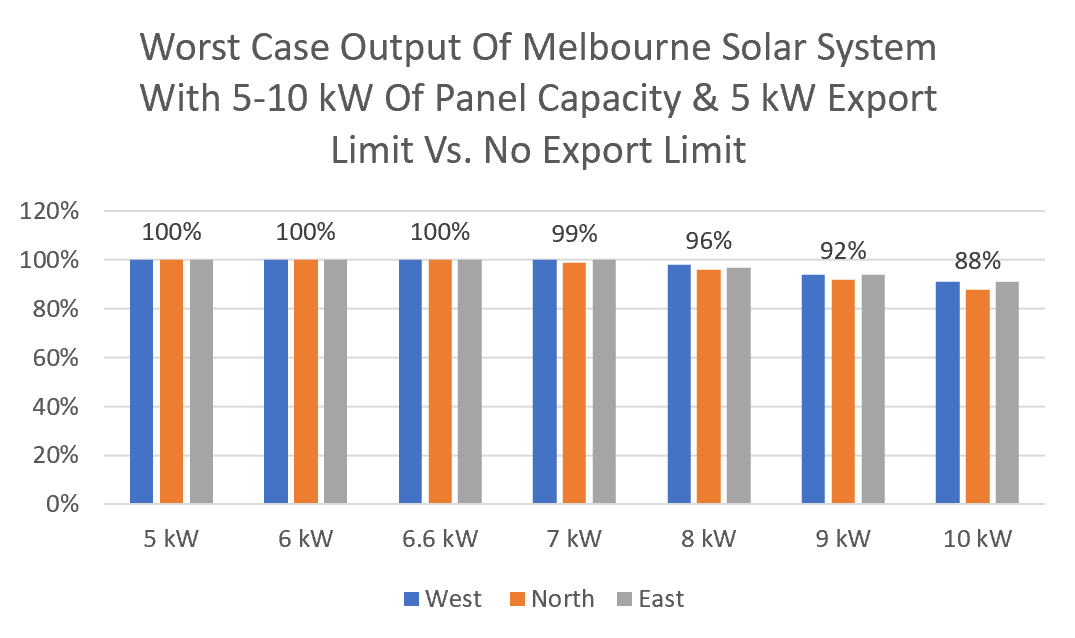
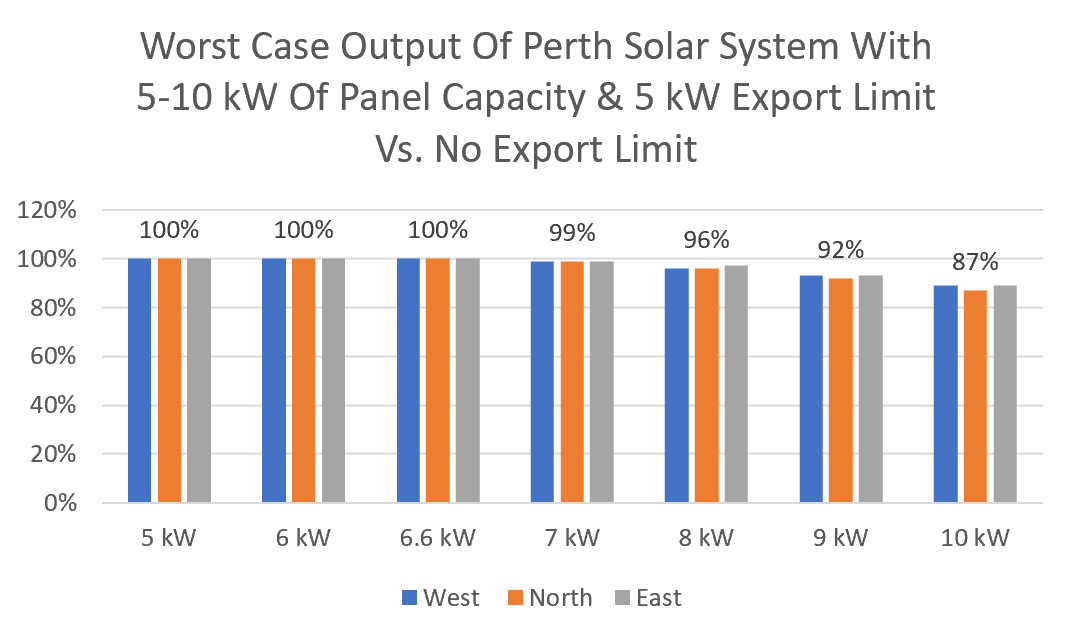
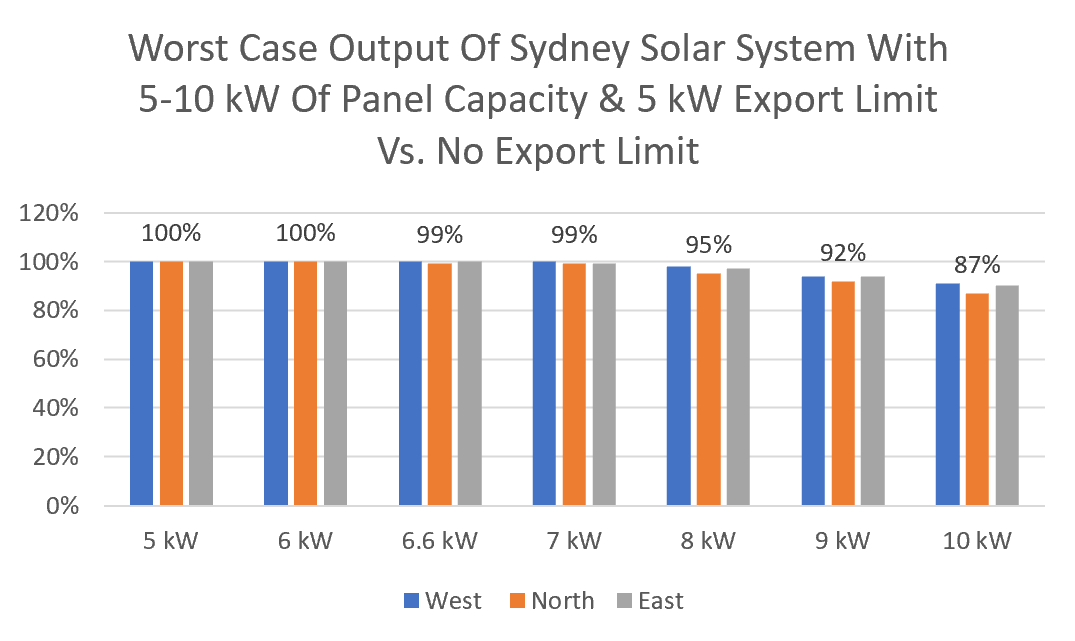
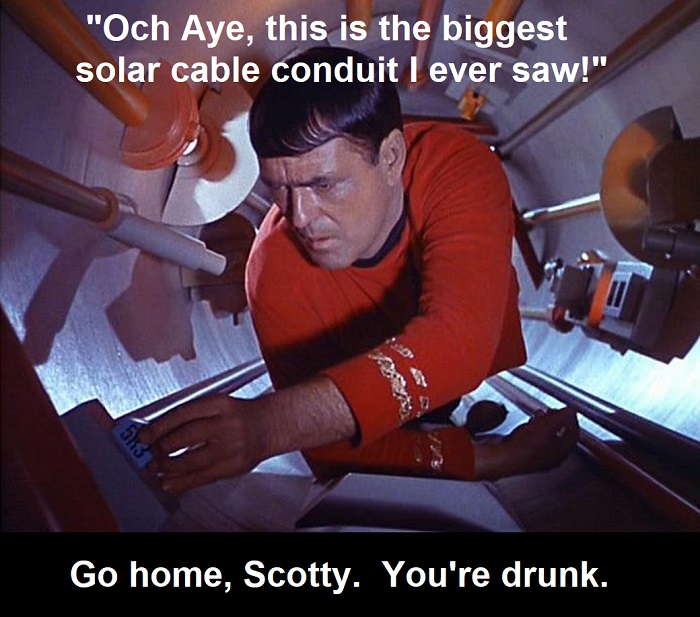
 RSS - Posts
RSS - Posts



I concur. We have 6.6kWp, limited to 5kW in Adelaide on a rental installed about 50:50 East West
For the short time I was monitoring its data, it had a lovely export bell curve, exported about 40kWh/day and imported 2kWh/day
And I never saw any clipping
So, Perth and Darwin are the only capitals with a 5kW limit on inverter capacity for single phase grid connections, and with no export limiting?
As I have previously asked, in the case of the unstable, unsafe, and, unreliable, decrepit SWIS grid, has any reason been given as to why the WA state parliament prohibits export limiting, and therefore, prohibits scenario’s such as 10kW inverters with 10-13kW panels capacity and 5kW export limiting, on single phase connections, as would apparently be allowed in every other state in Australia, and, which would otherwise have no detrimental effect on the SWIS grid, beyond what is already allowed?
Thus, for example, if Goodwe would have an inverter that would be a hybrid of its GW5048D-ES inverter and its GW5000-MS inverter, with the benefits of each, so that it could manage up to 10kW of panels generating capacity, and be export limited to 5kW, so that, while supplying up to 5kW of power to the household, and, concurrently, sending up to 5kW of power to charge a connected BESS, with any excess power above these two loads, of up to 5kW, being exported to the grid, the question must be asked – what effect would such a system have on an electricity grid, that would be different to the current 5kW single phase inverter limit that is oppressively and tyrannically imposed for connections to the decrepit SWIS grid?
Also, I note that, whilst the above article refers to “how much energy will you lose”, due to export limiting, the question is notsomuch how much energy the householder (or rooftop photovoltaic system owner) will lose, due to export limiting – it is the grid that will suffer the energy loss – the question should instead, be “how much is the financial benefit from exporting energy to the grid, that will be reduced by export limiting?”, and, that financial benefit, and, therefore, the possible financial benefit loss, from export limiting, will be reduced, as time passes, anyway, by progressively reducing feed in tariffs and increasing financial penalties to householders, for exporting to electricity grids.
I found much the same as RodM – export clipping won’t affect me much at all, due mainly to the fact that I’ve got a fairly high ratio of self-consumption already. (about 54% on average over a year). That’s due to ‘time-shifting’ changes I instituted as soon as I installed my system, and refined somewhat as time went by.
Much easier to do when you’re mostly home, most of the time, of course
I’ve got a 6.44 kw system in Greater Brisbane region.
I am in Melbourne and I had and existing 5kw of solar.
In August 2020 I added 6.6kw of panels with another 5kw inverter which included a 5kw export limiter.
I am now saving $8.02 per day which $4.30 can be attributed to the new added system. I do notice it being limited on sunny days but this is far outweighed by the many times when the system is not running at full capacity or I am using lots of power. I have a pool and electrically heated spa which run during the day.
For example, at this moment I am exporting 1.2kw to the grid and my new solar is generating 1.7kw. If not for my new system, I would be paying for peak power. Due to this, my saving calculation above is likely understated.
I am so glad I put on the extra 6.6kw system regardless of the 5kw export limit.
Well, I have 13kW panels with 10kW inverter in Sydney, North, 7 degrees tilted.
12 April 2021 – 69kWh generated, 59kWh exported, 11kWh imported
16 Jan 21 – 93kWh generated, 81kWh exported, 9kWh imported.
If I cap it at 0 export it will discard 80-90%.
Hi Michael
While this makes all terribly sense, I have a question that is not touched at all:
I have 3-phase access with a 10kW per phase limit – GREAT!
Installed are 2 systems with 5kW inverter and 6.6kW panels each and across 2 of the phases.
This means I could in theory add another 20kW inverter capacity, which is technically feasible as it’s a rural property with a huge transformer next to it and only 2 homes hooked up to the transformer. And yes, I have enough roof space.
Now comes the issue: my retailer allows a maximum of 10kW – nothing more.
My question is if I limited a total of 3 5kW inverters to a maximum of 10kW output, is that now a 10 kW system for the retailer or still a 15kW system?
Interesting discussion but you have wandered from the real problem Ronald. We have a coal owned government intent on allowing renewable energy to fail with its success and then claiming those of us who put on rooftop solar have caused their own pain.
Your story should be along the lines of ‘the country has been abandoned by a government which is not a government of the people’.
In the end any government which does not try to create new age jobs dooms its nation to failure along with the loss of huge numbers of jobs and third world status. Of course the coal industry thrives when the future is disrupted. Australia should be a solar leader but is instead a buyer of equipment sold to it by other nations. And still they vote in coalition governments………. What can I say.
Hi Michael
Fully agree with your thoughts!
There is a striking precedence for that in the English history. After cars were invented over there the government forced someone to walk in front of the cars waiving a flag as they were soooooo dangerous! We all know where the English car industry is nowadays. Not existing anymore and/or taken over.
And a quote I love:
“History teaches us, however, that when the times are ripe for change and the government refuses or is unable to change, either society starts to decay or a revolution begins.” ― Mikhail Gorbachev
very strange logic – if you disrupt coal stations now by subsidizing solar panels and forcing offtake and prohibiting charging extra for supply at night then you are disrupting the future….
Reality is that the solar industry just imports solar panels and a solar led future is extremely improbable because any equipment installed to make anything requires maximum use and hence constant power. The hydrogen future for Australia is a myth as all other OECD countries use nuclear to provide power and this nuclear power is constant and hence maximises the use of the equipment used to split out hydrogen and so hydrogen will always be produced in each country with no compression or transport costs.
While they haven’t really said very much about it, I believe BHP is very thankful for the low average electricity price they are now paying in South Australia — which is the Australian state with the most solar and wind power.
Malcolm, have a look at the costs of retiring nuclear power plants when they have been damaged (Chernobyl/3 Mile island/Fukishima) or when they are decommissioned. The costs of cleaning up the sites are far more than their enormous construction costs. As an example, do a search on UK nuclear power stations under closure, you will be aghast at the true costs (borne by taxpayers) of nuclear power. It simply can’t compete with renewables and increasingly effective battery technology.
The other issue is the waste itself. Sticking in drums in the desert is a moron’s view of an intelligent solution. The stuff has a half life of up to a million years. What that means is that after a million years it’ll be half as radioactive as it is now. Still deadly of course.
I cannot for the life of me understand the BS about clean nuclear as its more deadly than the Coronavirus will ever be and its there forever in human terms.
If anybody wants nuclear then let it be stored next door to the place they call home.
Safely disposing of nuclear waste is a costly issue, but it’s not the stuff with a half life a million years that is real problem. The longer the half life, the less radiation it gives off. It’s the high level waste sitting around in cooling ponds, such as the ponds near many US reactors, that’s extremely dangerous.
Selected half lives and radiation:
* U-238: about 4.5 billion, decays emitting alpha particles
* U-235: about 700 million, decays emitting primarily alpha particles, and sometimes accompanied by spontaneous fission of minute quantities (parts per billion) emitting gamma radiation
* U-234: about 24,000 years, decays emitting primarily alpha particles, and sometimes accompanied by spontaneous fission of minute quantities (parts per billion) emitting gamma radiation
* U-233: about 160,000 years, decays emitting primarily alpha particles, and sometimes accompanied by spontaneous fission of minute quantities (parts per billion) emitting gamma radiation
* Pu-239: about 24,100 years, decays emitting primarily alpha particles, and sometimes accompanied by spontaneous fission of minute quantities (parts per billion) emitting gamma radiation
Alpha emitters are only hazardous if ingested, inhaled, or enter through a wound. Alpha-emitting radioactive isotopes are most dangerous to humans when inhaled, lodging in the lungs, and killing lung cells, leading to lung disease and cancer. From the lungs, they can migrate into the bloodstream, to the kidneys, and concentrating in the bones, liver and spleen. Ingestion via contaminated food and/or water is not as readily adsorbed, and is mainly passed, but can be damaging to sensitive tissue while passing through.
https://www.epa.gov/radiation/radiation-basics
I think it’s fanciful to expect that longer-lived alpha-emitting radioactive material can be safely stored for hundreds to thousands of years (let alone tens of thousands of years or more) and prevented from entering the environment.
U238 and U235are in ore (U235 less than 1%). They do decay and have no regard to what we want. The choice is whether we decay them to obtain power or we let them decay in ore. They will decay anyway.
And for whether spent fuel can be safely stored look what France does as obviously they have no issue with reusing spent fuel as mox and they had no issue with burning out long living isotopes using breeder until someone made stupid decision to close Superphoenix.
Darek (re your comment at April 27, 2021 at 1:25 pm).
You state: “And for whether spent fuel can be safely stored look what France does as obviously they have no issue with reusing spent fuel as mox…”
France made the decision to rapidly expand their nuclear power capacity in 1974. That’s 47 years ago. I’m talking about safely storing high-level nuclear waste for one or more ORDERS OF MAGNITUDE longer.
I’d suggest France’s nuclear reactor fleet is looking a bit long in the tooth. The average age in 2020 was 34.25 years.
https://en.wikipedia.org/wiki/Nuclear_power_in_France
Construction on the only new reactor, Flamanville 3, began on 4 December 2007. The new unit is an Areva European Pressurized Reactor type and is planned to have a nameplate capacity of 1,650 MWe. EDF estimated the cost at €3.3 billion and stated it would start commercial operations in 2012, after construction lasting 54 months. The latest cost estimate (July 2020) is at €19.1 billion, with commissioning planned tentatively at the end of 2022.
https://en.wikipedia.org/wiki/Flamanville_Nuclear_Power_Plant
France is an experienced nuclear power country, and it seems to me they are having serious problems building a new nuclear plant. They don’t seem to be in a rush to build more, to replace the oldest reactors that are now 40+ years old.
You also state: “…they had no issue with burning out long living isotopes using breeder until someone made stupid decision to close Superphoenix.”
It seems to me Superphoenix was a costly exercise with very poor reliability and low capacity factor (7%). According to a 1996 report by the French Accounting Office (Cour des Comptes), the total expenditure on the reactor to date was estimated at 60 billion francs (9.1 billion euro).
https://en.wikipedia.org/wiki/Superph%C3%A9nix
How does all this limiting stuff work with micro-inverters?
A sensor detects how much solar power the home is exporting to the grid so the solar system knows to ease off if the export limit is about to be exceeded. Here’s an explanation of how it works:
https://support.solarquotes.com.au/hc/en-us/articles/360000030495-How-does-a-solar-export-limiter-work-
So the sensor tells each microinverter to throttle back? That’s a lot of chatting!
Sounds easier with a single inverter.
I wonder what signalling is proposed to make me aware of such charge to let me stop export. I believe I must be aware up front before I am charged for export.
Yes, the total losses are low, but the losses are better thought about on a marginal basis — as the capacity exceeds the export limit, losses increase faster and faster. Take Sydney from your examples:
– At 7kW on the roof, potential average export is 7kW * 99% = 6.93kW
– At 8kW on the roof, potential average export is 8kW * 95% = 7.60kW
– At 9kW on the roof, potential average export is 9kW * 92% = 8.28kW
– At 10kW on the roof, potential average export is 10kW * 87% = 8.70kW
Expanding from 8->9kW produces an exportable gain of 0.62kW (38% losses) and expanding from 9->10kW only produces an exportable gain of 0.58kW is exportable on average (i.e. 42% losses). That last kW or so of panels might not be a good investment…
That is a good way of looking at it, but I’ll mention two things:
1. The figures I gave are for an absolute worst cast situation. In practice most large systems will have panels facing more than one direction which will reduce losses and using electricity in the middle of the day also reduces them further.
2. The marginal cost of adding extra panels is normally less than the average cost.
In my area of Melbourne export limit is 10kw fortunately. If in the future this gets decreased is some sort of grandfathering likely, or will the system just be capped at whatever the distributor feels like?
It will almost certainly be grandfathered in and already installed solar systems left as they are. It is simply not practical to require existing solar systems to be export limited. It’s a bit like the difference between requiring all new cars to have airbags and requiring them to be installed in all existing cars on the road. One’s a lot easier than the other.
Ronald,
I’ve found this discussion thread really interesting/useful; however, I’m still struggling a bit with what settings I should use on my inverter?
I have a 12.5 Kw array connected to a 10 Kw Goodwe single phase inverter.
I have a 5 kwh export limit.
So do I set 50% of the power output as my export limit or something like 85%?
I’m based in Auckland NZ so at approx 36 degrees south with all North facing panels set at a 15 degree pitch so the performance of my system probably something like that seen in Melbourne. .
I’m not looking for an exact answer, more an understanding of the principles one applies when setting up an inverter. The manuals are zero help on this front!
Has anyone crunched the numbers on a larger system installed in Perth?
The rules allow for larger systems to be connected.
Eg 3 phase system 10-15kVA where it is limited to 1.5kW export
Hi Dan, we’ll look into this and let you know. We may even write a blog post on it!
Trevor, Can you share what you found out about a larger system in Perth? Mistake #3 Not installing enough solar…
“Put on as much solar as you can reasonably fit and afford.”
I appreciate when it comes to the crunch only I can make the decision. I would find it great if I can get advice or hear others experiences what they did, why and what they didn’t do and why? Any discussion, info or details around the question from Solar Quotes would be extremely helpful. Facebook doesn’t have Solar Panel Groups and I can’t find any forums where I might get more info on this dilemma.
I’d be interested to know your thoughts on the speed bump I’ve just come across in my journey to have solar installed (the whole process has been a nightmare).
A 6.6kW system, 5 panels east side, 10 panels west side, and have just been told that I have to export limit to a measly 2.29kW!
Got me wondering whether it’s actually worth it.